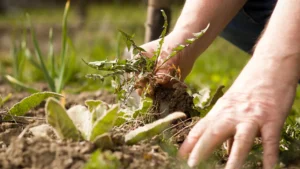Back to: Pre Vocational Studies Primary 5
Welcome to class!
Hello my diligent student! It’s wonderful to have you back and ready to learn more about farming. Today, we’re going to talk about “post-planting operations.” This means all the things a farmer does after planting their crops. It’s like taking care of a baby after it’s born – you need to feed it, keep it clean, and make sure it’s healthy. Let’s begin!
Meaning of Post-planting Operations

We’ve learned about pre-planting operations (what farmers do before planting) and planting activities (the act of putting seeds in the ground). Now, post-planting operations are all the activities a farmer carries out after the seeds or seedlings have been planted. These operations are essential for ensuring that the crops grow well and produce a good harvest.
Here are some important post-planting operations:

- Weeding: Weeds are unwanted plants that grow alongside crops and compete with them for water, nutrients, and sunlight. Farmers remove weeds regularly to ensure that their crops have enough resources to grow. Weeding can be done by hand, using tools like hoes, or by using herbicides (chemicals that kill weeds). It’s like removing unwanted toys from your play area so you have enough space to play comfortably.
- Watering/Irrigation: Plants need water to grow, so farmers ensure that their crops get enough water, especially during dry periods. They may use different irrigation methods, such as sprinklers, canals, or drip irrigation. It’s like giving your pet water to drink so it stays healthy.
- Fertilizing: Fertilizers are substances that provide nutrients to plants, helping them to grow bigger and stronger. Farmers may apply different types of fertilizers, such as organic fertilizers (like manure) or inorganic fertilizers (chemical fertilizers). It’s like giving your body healthy food to eat so you grow strong and tall.
- Pest and Disease Control: Pests are insects or other animals that eat or damage crops. Diseases are caused by microorganisms like bacteria or fungi. Farmers use different methods to protect their crops from pests and diseases, such as using pesticides (chemicals that kill pests) or practicing crop rotation (planting different crops in the same field each year). It’s like taking medicine when you’re sick to get better.
- Thinning: Sometimes, too many seedlings grow in one place. Thinning involves removing some of the weaker seedlings to give the stronger ones more space to grow. It’s like sharing your toys with your friends – if you have too many, it’s better to share some so everyone has enough.
- Supplying: If some seeds fail to germinate (start to grow), farmers may replant new seeds in those empty spaces. This is called supplying. It’s like replacing a broken toy with a new one so you can continue playing.
- Mulching: Mulching involves covering the soil surface with organic materials like straw, leaves, or wood chips. This helps to conserve moisture in the soil, suppress weeds, and regulate soil temperature. It’s like putting a blanket on your bed to keep you warm at night.
- Staking: Some crops, like tomatoes and climbing beans, need support to grow upright. Farmers use stakes or trellises to support these plants. It’s like using training wheels on a bicycle to help you learn how to ride.
Let’s use an example. Imagine a farmer growing tomatoes. After planting the tomato seedlings, they regularly weed the garden to remove unwanted plants. They water the tomatoes regularly, especially during dry periods. They may also apply fertilizer to help the tomatoes grow big and juicy. They check the plants for insects and diseases and take action if needed. They might also use stakes to support the tomato plants as they grow taller. These are all post-planting operations.
Summary
So, to summarize, post-planting operations are all the activities a farmer carries out after planting their crops. These include weeding, watering, fertilizing, pest and disease control, thinning, supplying, mulching, and staking. These operations are crucial for ensuring a healthy and bountiful harvest.
Evaluation
- Can you name three post-planting operations?
- Can you explain why weeding is important?
Excellent! You’re doing a fantastic job! I’m so proud of your learning.
We have come to the end of this lesson.
In the next class, we shall be talking about the Identification of simple cooking tools and equipments.
In case you require further assistance or have any questions, feel free to ask in the comment section below, and trust us to respond as soon as possible. See you in the next class!
